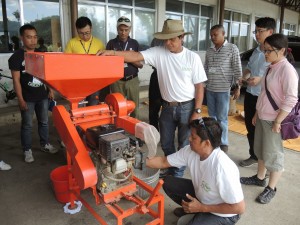Thierry Shema, a young Rwandan environmental engineer, and his associates are working on a prototype mobile grain dryers powered by renewable energy as opposed to diesel.
The dryer is being developed by Crop Tech Ltd., a start-up company formed by the group, to help reduce postharvest losses and limit exposure to aflatoxins.
Once the company arrives at a final design, it plans to partner with private companies to commercially manufacture the machines and deploy them under a leasing model.
Read the full story at The New Times
The bubble that dries
Sun drying is the most common drying method in the country, and also in Thailand, Cambodia, Laos, and India, among other tropical countries, because it is cheap. It uses the sun as the heat source. But, it is laborious and unreliable. An idea for a simple design came in 2012. It is made of two plastic sheets, a black one at the bottom where the grains are placed and a transparent one as roofing. Both sheets are connected by a zipper. It’s called the solar bubble dryer—“solar” because of the ambient temperature that provided heat from the sun for the dryer, and “bubble” because of the dome-like shape of the polyethylene plastic roof when set up.
Eclipsing the sun: flatbed dryers
In 2003, a rice-husk-fired dryer with 3.3-ton capacity was developed by the Indonesian Center for Rice Research in Sukamandi, and introduced in South Sumatra by the Assessment Institute for Agricultural Technology in Palembang. IRRI helped by transferring a bigger and more efficient fan to a local manufacturer in Palembang. Come 2010, around 200 dryers were installed in South Sumatra, mainly by rice millers. Four local workshops are now producing dryers there, with one shop in Palembang already making good-quality dryers.
Smarter, cleaner heat
If the searing heat wasn’t enough, the thick, dark smoke that engulfed the area surrounding the furnace made the workers want to give up. The smoke wasn’t confined only to the immediate vicinity, but it affected neighboring areas as well. This “smoke machine” was the inclined-grate design of a rice hull furnace used to provide heat to a flatbed dryer that is used to dry rice. Now, thanks to the new semi-automated downdraft rice furnace designed by experts at IRRI, farmers and seed producers have a better choice.







